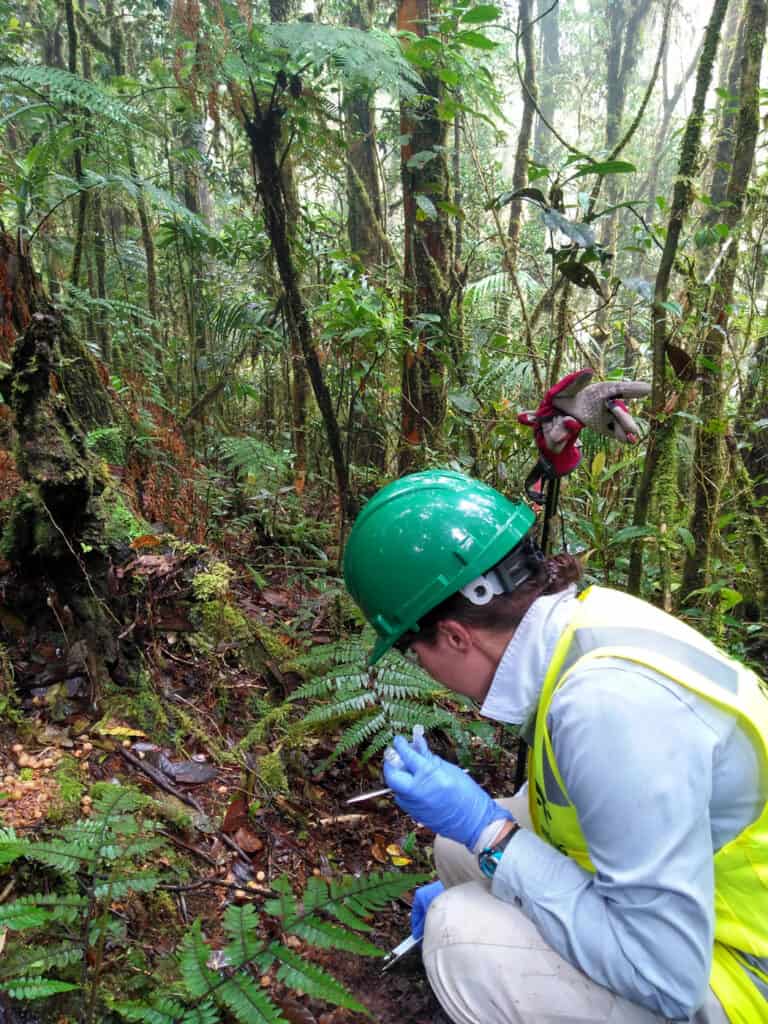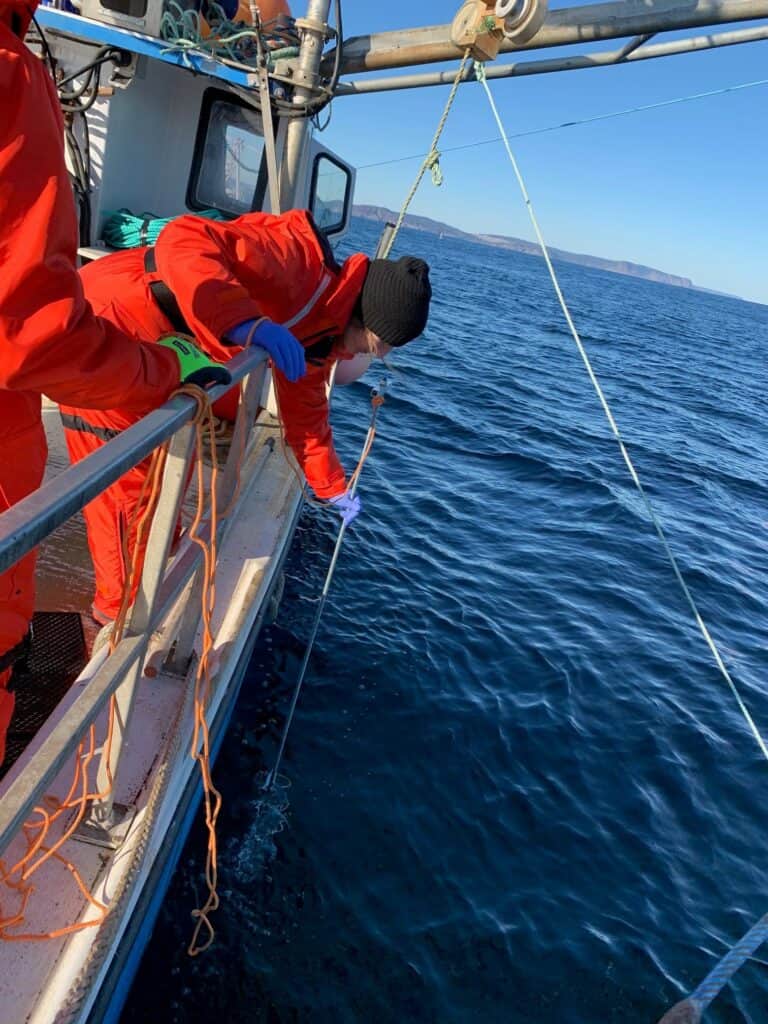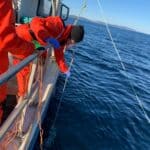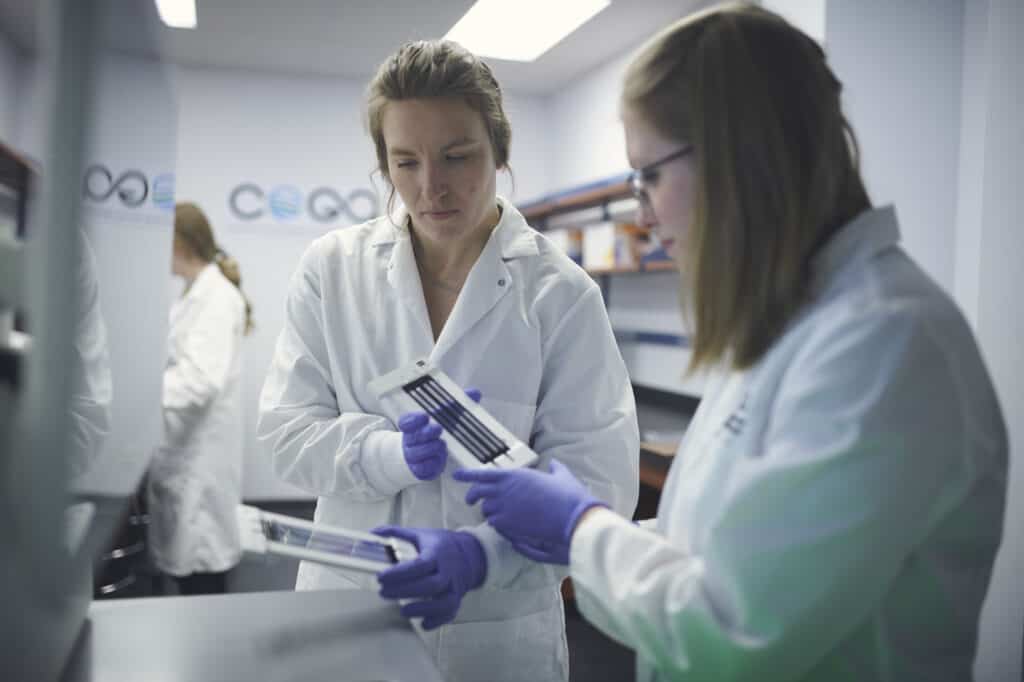by Jessica Leeder • Photos Courtesy of eDNAtec
Many of us know what it feels like to peer into a body of water—a mud-bottom pond, one of the Great Lakes, the frothing ocean—and wonder what lurks way down beneath. What mysterious habitats exist in those murky places? The complete answer to this question still puzzles scientists all over the world. For years, the creatures that swim, slither, and skitter their way through the deepest waters on Earth have evaded even the most determined research scientists. That’s because studying the depths of the ocean is nearly impossible. The traditional technology we use to explore the ocean—boats, trawl nets, underwater cameras, submersible robots—cannot typically extend to the deepest parts of the sea floor.
Lately though, scientists at a new, landlocked laboratory in St. John’s have been working on a new way of finding out what lives in the deep sea, one that requires researchers to look closely at the water (albeit through some very fancy microscopes). Through those high-tech lenses, they aren’t looking for fish scales or bits of lobster shell. They’re hunting for microscopic traces of cellular material known as environmental DNA (eDNA). Just as we humans leave fingerprints on surfaces we touch, or some of our skin cells rub off on straws we drink from, waterborne life forms, from tiny plankton to giant whales, leave traces of DNA in the water. Those breadcrumb-like trails are now being quietly uncovered in St. John’s. At eDNAtec, lab researchers can speedily detect the DNA of hundreds, and even thousands, of organisms in a single cup of water. The relatively new technology they use to do it is called metabarcoding. Already, it has led to discoveries of many living things that humans have never seen before, including organisms from some of the deepest and most hard-to-reach parts of the sea, located in the North Atlantic Ocean.
“The ocean is full of things that we haven’t even been able to describe yet,” says Nicole Fahner, Associate Director at eDNAtec. “There’s just more diversity of things than there are taxonomists with time to go and do the work to name them as species.”

Fahner and her team at eDNAtec have spent the last few years analyzing water samples as part of the Ocean DNA System Project. It brings together scientists from Fisheries and Oceans Canada (DFO), the Nunavut Fisheries Association (NFA), and Energy Research and Innovation Newfoundland and Labrador. The goal of this collaboration is to figure out how eDNA can be used to help monitor the ocean with more precision and less invasiveness. While each partner is interested in protecting the ocean environment, they also want to grow the ocean-related economy safely, adding jobs to industries, such as oil drilling, fishing, and more. Before they can do that though, they need to understand more about exactly what is living beneath the surface.
“You can’t protect and sustain something you can’t measure,” says Fahner.
The fact that DNA can be used at all to help monitor ocean life is thanks to work started by another Canadian scientist, Paul Hebert. A renowned biologist at the University of Guelph, Hebert gets credit for coming up with the concept of assigning barcodes, similar to the codes scanned on food packages at the grocery store, to every identifiable species in the world. The idea was to develop one massive catalogue of barcodes accessible to everyone in the world. That catalogue is known now as the International Barcode of Life (available at https://ibol.org); it is essentially a global reference library of millions of DNA sequences accessible online. Currently, there are more than 700,000 species catalogued; the goal is to increase that number to 2.6 million by 2026.
Ocean scientists use the Barcode of Life to help identify sequences of DNA they discover in various environmental samples, including sand, soil, and water. While the barcode’s existence has dramatically sped up biodiversity research related to the ocean, scientists are still “not even close” to documenting all underwater life forms, says Dirke Steinke, Associate Director for the Centre for Biodiversity Genomics at the University of Guelph.
“We understand some other planets better than our ocean floor,” he laments. “It’s staggering.” And Steinke would know. He was part of a global team of 2,700 scientists that undertook the Census of Marine Life, a massive, 10-year effort in which scientists all over the world set out to assess and categorize a huge spectrum of life in the ocean, from microbes to whales. Their work resulted in the creation of the first-ever inventory of marine life, which was made public in 2010. At that time, the inventory included more than 30 million records. Despite that mammoth number, Steinke says there is much left to discover. One example on the scientific bucket list is the depths of the Labrador Sea, a deep and frigid arm of the North Atlantic Ocean between Canada and Greenland that is clogged with ice for much of the year. Scientists have dubbed the hard-to-reach spot one of the “lungs of the sea” because it is one of few places where oxygen is pulled out of the atmosphere and down into the deepest part of the ocean. Through a process called deep water convection, the oxygen is redistributed below the surface throughout the Atlantic, Pacific, and Indian Oceans. That oxygen is essential to life forms at great depths. Evaluating the health of this vital area is a very difficult task; DNA testing of water samples could make it much easier than trying to use drag nets to catch specimens for sampling as explained by David Cote, a research scientist with Fisheries and Oceans Canada (DFO).
“You don’t necessarily need a big fishing boat or a trawler to go and collect a water sample,” says Cote. “All you need are some rubber gloves and to be able to scoop up some water and send it to the lab.”
If what Cote says is true, it means DNA sampling opens the door to just about anyone interested in helping collect water samples—students, say, or anyone living or working in a remote destination with access to water. In fact, one of the main goals of the Ocean DNA System project is to ensure that protocols for taking water samples do not require high-tech science training or cumbersome equipment. Ideally, samples can be easily taken and sent to the lab by just about anyone, anywhere. Achieving that goal could both reduce the costs of expensive scientific treks and widen the lab’s access to ocean water samples—which would also mean communities who send in samples will have a clearer picture of what lives in their waters.
“The goal is to develop a protocol that could be deployed on a commercial fishing vessel without a scientist present,” Fahner says. “We wanted to make something really straightforward and easy to follow, something that doesn’t require a very elaborate piece of equipment. Fishing vessels are already going out where the fish are, so it just makes sense,” she says, adding: “With oceans, a lot of the challenges are just getting to the spot you want to monitor. Why not use boats that are already going out to help answer the questions?”
In northern and remote locations, where using boats isn’t always an option, the collection protocol opens up the possibility of engaging community members to participate in gathering samples, including Indigenous groups who know their land—and water—better than any outsiders. DNA analysis, Cote adds, might even enhance local knowledge. “Labs can send you back a record of all the different animals that are living on your doorstep,” he says, adding: “There may be important habitats for that particular community.”
In Nunavut, there are high hopes that eDNA will shed light on sensitive species that could benefit from more precise monitoring, as well as some new possibilities for commercial fisheries. In May, the Nunavut Fisheries Association and eDNAtec signed an agreement to continue working together beyond the Ocean DNA System project, which will soon wind down. Brian Burke, executive director of the NFA, says there is a lot of room for the development of the inshore fishery in many communities in Nunavut. While communities would benefit greatly from growing their ocean-related economies, scientific information on local fish populations has been limited.

“The knowledge gaps [on inshore fish populations] are huge and we’re looking at how we can fill them,” Burke says. “You start with traditional knowledge and build that up, working with communities. Environmental DNA is one of the tools we can use.”
In the longer term, Burke’s hope is that several communities will develop their fisheries into viable economies. “There’s big socio-economic potential for those communities,” he says, adding that even if commercial fisheries aren’t established, identifying resources for community food security is just as important. Burke says the NFA is also working to get fisheries and marine careers—and the potential those careers hold for young students—into Nunavut’s school curriculum. “There’s very little information now on the potential for careers in the fishery or marine sectors,” he says. “We know there’s a large number of young Inuit who will come of working age over the next few years and we’d like them to know opportunities exist in the industry. It’s a real option for them.” Burke’s worry is that fisheries and marine careers risk being seen as a last resort pathway for kids.
“That’s changed,” he says. “We’re adopting technology now. We need people on our vessels with digital skills. It’s not the old fishery of the past.”
While no one is advocating that traditional technology be cast off, ocean scientists increasingly see a future that includes DNA analysis as part of their research kit.
“We are getting a whole bunch of information on understudied species that probably have a big impact on the overall ocean’s ecology … that, in turn, might help us understand how they’re affecting or impacting the abundance of the species that are really important to industry,” says Cote. Other species, such as corals or sponges that create important habitats but are typically not sampled by trawl surveys because of their sensitivity, can also be detected by DNA. The same is true of what Cote calls “important nursery zones” for commercial fisheries, which are zones too shallow or sheltered for trawling. Conducting water sampling in those areas could broaden researchers’ understanding of the habitat support required by a particular fishery without jeopardizing its health.
Despite the benefits of eDNA, there are answers it is unable to give—for now. At the top of that list is what ocean scientists refer to as “abundance,” which is a measurement of how many of a certain fish are actually in the water. In cases of commercially important species—cod, for example—regular science assessments are conducted to monitor the impact of fishing, predators, and other environmental and climate conditions on fish populations. Those assessments tend to require the use of large research vessels, trawlers, robotic submersibles. and other expensive technologies. They are also fairly invasive, in that they involve hauling fish and bycatch out of the water. But there is no way around them, says Cote, because environmental DNA can only tell us whether a fish is present (or was present recently enough to have left behind genetic material). It offers no hints as to the size of a fish population.
“It’s not a perfect technology alone, nor is any other conventional technique,” Cote says.
Although surveys that involve removing fish from the water are more destructive, they do allow scientists to test specimens for containment loads and to assess the age and size of the animal. “Those kinds of things are really important when we’re trying to understand the health of a population and you can’t get that right now from eDNA.”
What eDNA can do, its advocates argue, is help Canada refine its approach to protecting the oceans it borders during a time of significant environmental pressure. The easy-to-get nature of water samples makes it easy to use them to establish benchmarks against which ocean sustainability can be measured over time. This argument is put forward by Mehrdad Hajibabaei, the founder of eDNAtec. Hajibabaei is concerned that Canada’s current approach to protecting sensitive environmental areas in Canada is insufficient and inconsistent. This is in spite of the fact that Canada is working to preserve 30 per cent of its coastal territories as Marine Protected Areas (meaning they are legally set aside for conservation from the seafloor to the surface) by 2030.
“What will we do to measure and confirm that we really are protecting these areas?” Hajibabaei wrote recently. “The current data collection tools that we have are fantastic but simply not enough,” he wrote. “eDNA can be added to the toolbox to … precisely measure the biological layers of any ecosystem.”
Imperfect as it may be, one thing is clear: eDNA has given us a window into many forms of ocean life that, until recently, we had no means of viewing. Now that we can see into deeper depths, we can step up efforts to protect and sustain our oceans.



